By Adam Pagnucco.
Money talks and people are talking about money. That’s the vibe in CD8, which could turn out to be the most expensive congressional race in Maryland history. Bethesda Magazine’s Lou Peck and the Washington Post’s Bill Turque have written about the overall numbers and individual donors in the race. Today, I dig deep into the data to reveal more details of the Democratic candidates’ fundraising.
First, the top-line numbers through the third quarter reported by Kathleen Matthews, Senator Jamie Raskin (D-20), Delegate Kumar Barve (D-17), Will Jawando, Delegate Ana Sol Gutierrez (D-18), David Anderson and former Montgomery County Council Member Valerie Ervin (who has withdrawn). Much of this has already been reported and it shows Matthews first, Raskin a close second and Barve third. With almost $3 million raised and more than two quarters to go, this race looks like a record breaker.
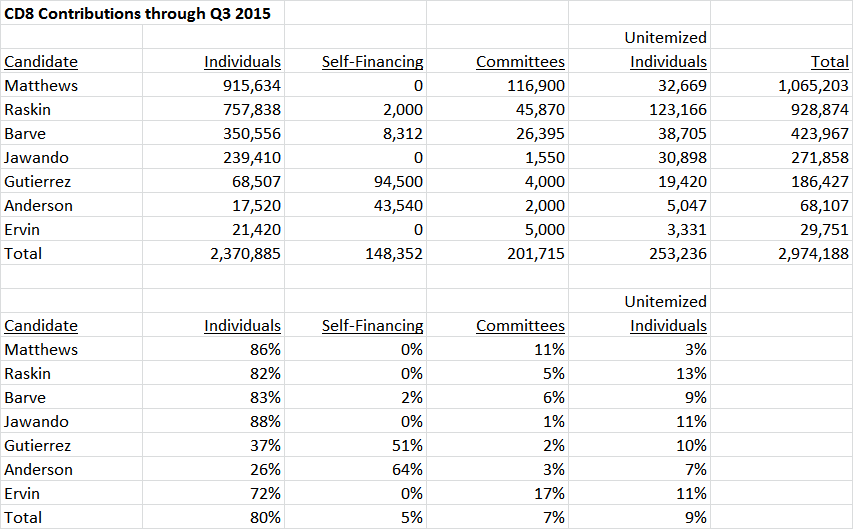
Unlike state and county contributions, federal contributions must be designated for the primary or the general. Among primary contributions, Matthews’ lead over Raskin grows slightly.
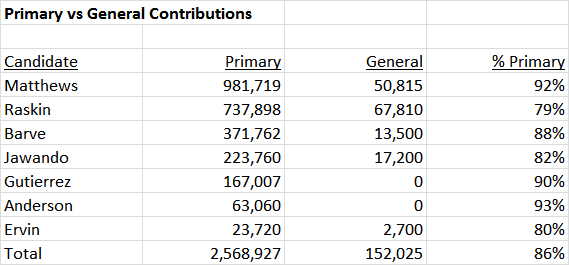
Burn rate is the percentage of money raised that has already been spent. Matthews’ burn rate (16%) is far lower than Raskin’s (25%) or Barve’s (35%). That reflects her strategy of saving up for television.
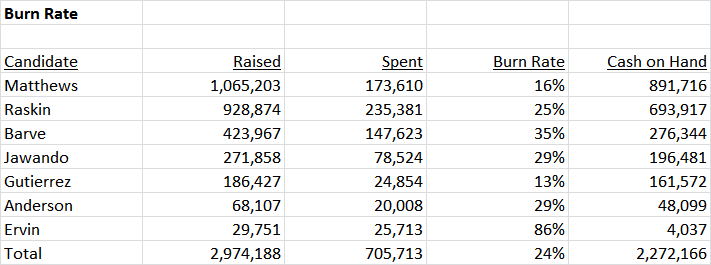
Matthews leads in big contributions. Her average individual contribution is nearly twice the amount of the rest of the field. Almost half of her fundraising has come from maximum individual contributions of $2,700 each. So far, Matthews has received more maximum checks than the rest of the field combined.
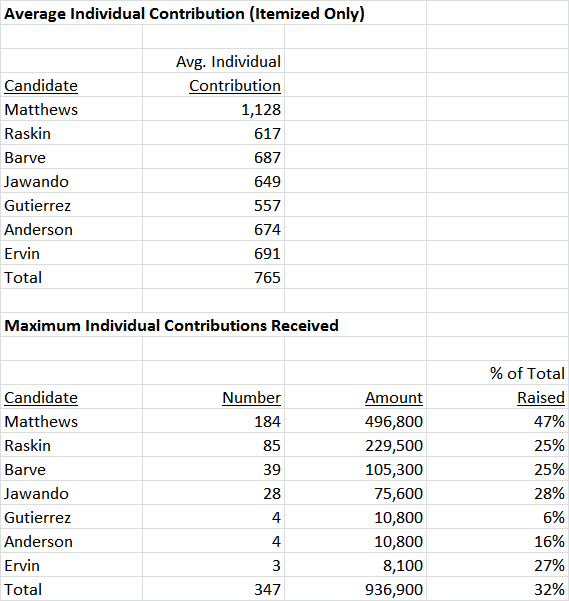
While Matthews has raised the most money, Raskin has a big edge in money raised in Maryland. In-state contributions have accounted for half of Raskin’s total, much higher than Matthews’ 23%. Barve’s in-state 45% ranks second, though he has raised less than half of Raskin’s total in Maryland.
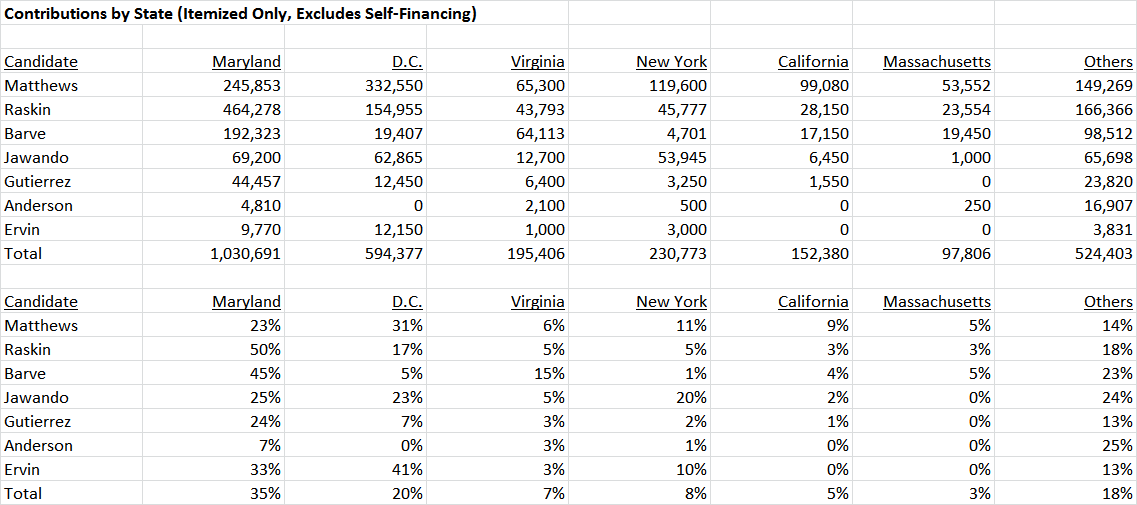
Here’s a look at fundraising from individuals in selected communities. The top seven locations are the largest population centers in CD8. Matthews leads in Chevy Chase and (narrowly) in Potomac, but Raskin has the lead in most other places. The bottom seven locations are major sources of contributions outside CD8 and Matthews leads everywhere (including in D.C.). Interestingly, Matthews has raised more money from New York City than from Bethesda. Also, Matthews has raised more money from Los Angeles than from Silver Spring, Takoma Park, Rockville and Kensington combined. That reflects her ability to tap into the Democratic establishment’s national donor network.
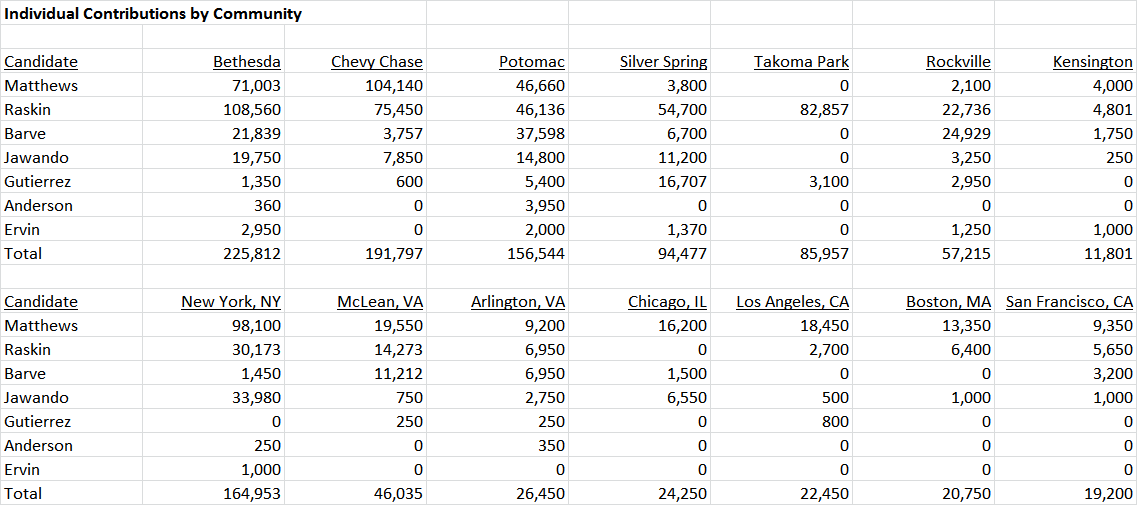
Here are a few takeaways from this data.
- Kathleen Matthews’ campaign was predicated on blowing away the rest of the field in fundraising. That is happening with the notable exception of Senator Jamie Raskin, who has so far remained close to her. One factor that could change that is if Matthews’ wealthy supporters open a Super PAC on her behalf. Super PACs are not supposed to coordinate directly with candidate campaigns, but they can raise unlimited contributions and spend them on both positive and negative communication. One can easily imagine twenty Matthews supporters each chipping in $100,000, thereby instantaneously bringing an extra $2 million into the race for their candidate.
- Senator Raskin’s strategy of community organizing is paying off big-time for his fundraising. He is leading or nearly tied in fundraising in every populous CD8 community except Chevy Chase and his relatively low average contribution rate leaves plenty of room for repeat contributions. His two biggest challenges are countering Matthews’ likely appeal to women and what happens to his campaign once he has to go back to Annapolis for session next January.
- The other candidates are either plainly non-viable or on the verge of getting there because they have not been able to keep up in the money race. That may have been a factor behind the Sierra Club’s endorsement of Senator Raskin. Delegate Barve is the Chair of the House Environment and Transportation Committee and that gives him enormous ability to shape state environmental legislation. He has been a serious player on a wide range of environmental issues that long predates Senator Raskin’s service in the General Assembly. The Sierra Club faced a tough choice between the two candidates from the perspective of policy and record, but they chose to jump in for Raskin. That’s not a knock on Barve, but more likely a judgment that Raskin is a stronger choice to take on Matthews. If more progressive groups make that kind of decision, the race will consolidate into a two-person contest between Matthews and Raskin.
And if that happens, here is the key question that will determine who wins. What will matter more? Senator Raskin’s large, enthusiastic and growing grassroots network? Or Kathleen Matthews’ fundraising prowess, media skills and membership in the electorate’s largest sub-component, white women? Your guess is as good as mine!
